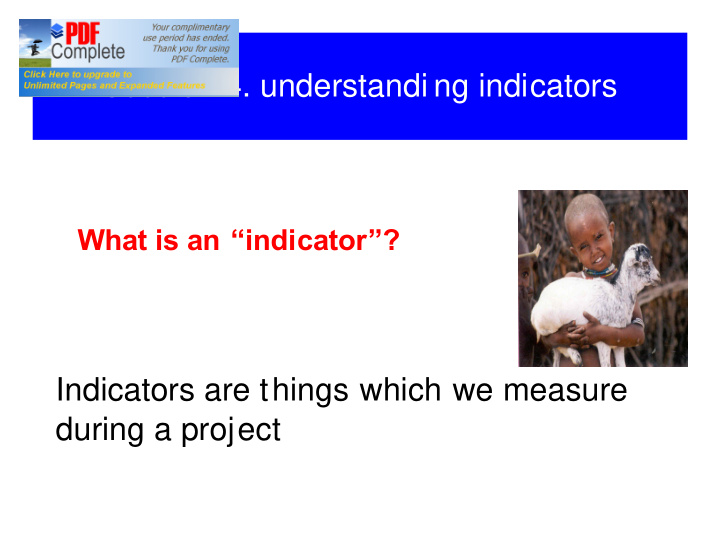



Session 4. understandi ng indicators What is an � indicator � ? Indicators are things which we measure during a project
Group exercise : Identify one existing project which you know well, and then list, on flip chart, the indicators which are used to measure this project. Time = 15 minutes to do this
Types of indicators : � Process indictors : measures � things being done � and help us to know whether project activities are being implemented as planned. e.g. Procurement of inputs Distribution of seeds, tools, fertilizers, drugs Number of trainings provided � Impact indicators : measure the end resul t on people at community level of � things being done � . They assess the fundamental aspects of people � s livelihoods such as their nutrition, income, health, security and political voice
Group exercise : Look at your list of indicators categories each indicator as either a process indicator or an impact indicator You have 15 minutes to do this
Proportion of process versus impact indicators? Most aid projects focus on the measurement of process. Why?
Projects tend to focus on process i ndicators for reasons such as: � It is easier � donor reporting system � Impact assessment methods are not well understood � Organizational incentives � a belief that � the more indicators we have, the more we know � � a belief that impact is something which is measured by outsider, consultants, experts
More is best? � Many development projects have too many indicators, particularly at the level of Outputs (or Objectives). � Indicators are reflections of reality-no group of indicators tells you the whole truth � A key aspect of M&E is careful selection of a limited number of useful indicators � It is always better to measure a small number of indicators well, rather than measure a large number of indicators badly.
Community-defined impact indicators Who identifies the impact indicators? Participatory impact assessment uses, as far as possible, community-defined indicators of impact
Community-defined indicators � Local people have their own way of describing change, and their own priorities for improving their lives � Participatory impact assessment (PIA) works with communities to identify locally-defined impact indicators
How can we identify community impact indicators � What changes in their life they expect to occur as a direct result of the project? � What changes have already occurred as a direct result of the project? � Asset (livestock, natural resources mgt) project: � how they benefit from the ownership or use of the asset / resource � Skill transfer / training project: � how the training or improved skills will benefit them
� When identifying the impact indicators, be specific not general. For example, � The goats give me milk � is not very specific. A better and more specific indicator is � The children drink the goats milk � or � I use the income from selling milk to pay school fees � . Similarly, the indicator � I have more status in the community � is not very specific. A better indicator might be � I can now join the local savings and credit group in the village � . � If the community or beneficiaries produce many impact indicators, prioritize the indicators using ranking. Try to identify the five most important impact indicators.
Example: Benefits derived from livestock Benefits derived from cattle, Dink Rek communities: CAHWs project, Tonj County, South Sudan 1999. Method: standardized proportional pilling with 10 community groups Some of these benef its can be used as impact indicators.
Group exercise Impact of restocking project 1. Report of restocking programme for internally displaced people in Fik zone, Ethiopia 2. Report of restocking programme in Wajier and Mandera districts, Kenya � Assess the relevance of the indicators: livelihood impact indicators? � How specific the indicators are? Time = 15 minutes to do this
Recommend
More recommend